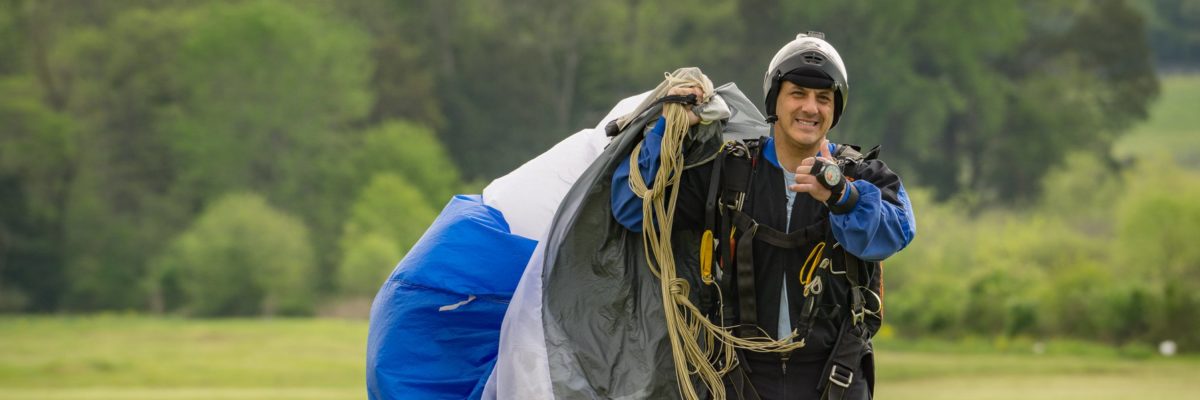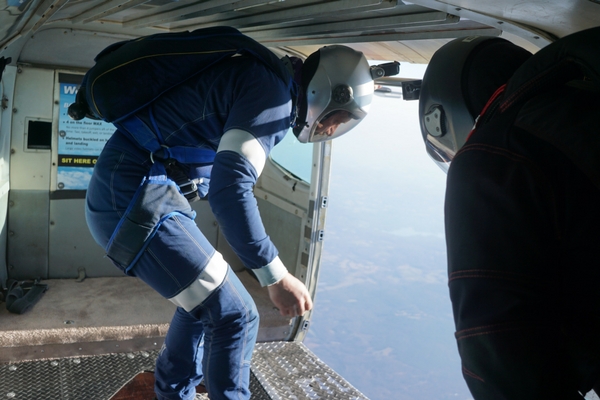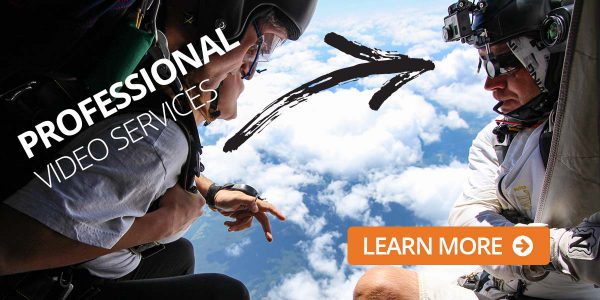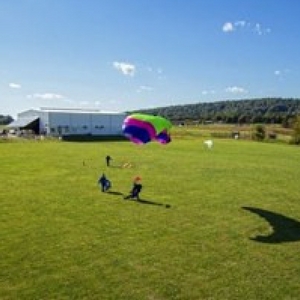
What Is A Hop-N-Pop?
Wednesday, September 14, 2022
- Skydive Orange
- 9/14/22
- 0
- Skydiving Information
Did you know that there are different altitudes that skydivers can jump from? They are normally split into three categories: high altitude, normal altitude, and low altitude. A normal altitude jump is usually anywhere from 8,000 ft to 14,000 ft. During a normal altitude jump, you will usually achieve about a minute (or less) of freefall and a 5-minute canopy ride. Low altitude jumps take place anywhere from 3,500 to 5,500 ft and are sometimes referred to as “hop-n-pops” in the skydiving world.
But what does that mean and WHY even do a hop-n-pop? Read along for everything you need or want to know!
WHAT DOES “HOP & POP” MEAN?
“Hop-n-pop” is a term for licensed skydivers and it literally means to “HOP” out of the plane and “POP” your parachute right away. If done at a low altitude, this means there is essentially no freefall because there simply isn’t enough time to freefall before you need to deploy your parachute.

Most skydivers need a minimum altitude of 2,500 ft to deploy their parachutes in order to have enough time to ensure that the parachute opens properly and is steerable. If the main parachute is not functioning properly, they may need to cut the main parachute away and deploy the reserve, or backup parachute, and achieve a safe canopy ride.
Hop-n-pops can be done at a higher altitude as well, but still have minimal freefall since the goal is to get under the parachute quickly.
WHY WOULD YOU WANT TO DO A HOP-N-POP?
Skydiving is all about the freefall, right? Not so much! The purpose of a hop-n-pop is to focus on the parachute, or canopy portion, of skydiving. Whether you just enjoy parachuting, want to improve your canopy piloting skills, or are practicing for a competition, hop-n-pops are the best way of getting to the point while also avoiding a bunch of air traffic.
Most skydivers take the plane up to full altitude, but a hop-n-pop is usually performed at a lower altitude, which means you will exit the aircraft before everyone else. Fewer people in the air at the same time translates to more space to play around in!
Tandem skydiving requires a minimum altitude of 8,000 ft to jump, making low-altitude hop-n-pops for licensed and student skydivers only.
PRACTICE CANOPY SKILLS
Whether you’re competing, taking a canopy course, or just working on canopy skills for your personal growth, becoming a better canopy pilot is important! Skipping freefall altogether can help you focus on canopy piloting.
When going through the Accelerated Freefall (AFF) program to get a skydiving license, hop-n-pops are required to practice for emergency exits due to aircraft malfunction and to get a feel of a subterminal parachute opening rather than an opening while traveling at terminal velocity on a normal jump.
CRW (CANOPY RELATIVE WORK)
CRW (pronounced “CREW”) is all about creating beautiful formations in the sky by hooking onto other skydivers’ parachutes. CRW requires a lot of practice and focus, and since it is a parachute-only discipline, it is best honed through hop-n-pops (though usually from a higher altitude).
SWOOPING
Swooping – another parachute-only discipline – involves the act of increasing the descent rate of the parachute through a turn to increase the forward momentum across the ground. Because swooping is a very advanced maneuver, it is only recommended for experienced skydivers. Swooping is best done with less air traffic, so swoopers tend to … you guessed it … prefer hop-n-pops!
LOW CLOUDS
Another reason for a hop-n-pop is low clouds. If clouds roll in at a lower altitude, then your only ‘jumpable’ option might be a hop-n-pop!
HOP-N-POP FROM THE TOP!
A phrase you may, or may not, have heard! “Hop-n-pop from the top” means going to the full or maximum altitude and pulling your parachute right away. You’ll take a slow, 10 to 15-minute ride back down to the ground (depending on a few factors of course). This hop-n-pop is usually performed during a sunset jump because it gives you more time to take in the scenery and enjoy the tranquility of floating above the air away from it all.
Perfecting your parachute piloting skills is an often forgotten, yet extremely important part of skydiving. The parachute is the most important part of the skydive. It IS the thing that ultimately saves your life, after all! Hop-n-pops help to make better canopy pilots and safer overall skydivers!
Have more questions? Contact one of our amazing team members or join us at Virginia’s premier drop zone, Skydive Orange, and get some jumps in! Blue skies and happy hop-n-pops!
The largest tandem skydiving center near Northern Virginia, Washington D.C. and Maryland.
Copyright © 2025, Skydive Orange, All Rights Reserved.
DropZone Web Design & Marketing by Beyond Marketing, LLC


